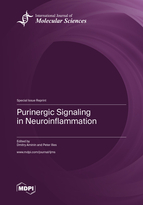Purinergic Signaling in Neuroinflammation
A special issue of International Journal of Molecular Sciences (ISSN 1422-0067). This special issue belongs to the section "Molecular Pathology, Diagnostics, and Therapeutics".
Deadline for manuscript submissions: closed (30 November 2021) | Viewed by 47396
Special Issue Editors
Interests: biochemistry; cell biology; structure and function of biological membranes; mechanism of biological activity of natural and synthetic biologically active substances; new drug discovery; molecular targets; toxicology; ecotoxicology; biomarkers; biosensors
Special Issues, Collections and Topics in MDPI journals
Interests: neuropharmacology; neurotoxicology; purinergic mechanisms; modulation of synaptic transmission; glial cells; necrosis/apoptosis; analgesia; learning and memory; epileptic state
Special Issues, Collections and Topics in MDPI journals
Special Issue Information
Dear Colleagues,
It is clear today that the physiological effect of extracellular ATP is mediated by its interaction with specific purinergic receptors. All purinergic receptors are divided into P1-purinoreceptors (the main ligand adenosine) and P2-purinoreceptors (the main ligands ATP/ADP, UTP/UDP). Each of the subtypes is divided into a number of families. For instance, P2 receptors are divided into P2X and P2Y receptors according to the mechanism by which their effect is realized: P2Y are G-protein coupled receptors, while P2X receptors are ligand-operated ion channels (or ionotropic receptors). P2X receptors are important molecular therapeutic targets, the malfunctioning of which leads to serious complications in the physiology of humans and animals, and cause dangerous diseases. The search for compounds that can modulate the function of purinergic receptors can lead to the creation of new drugs that are effective in the treatment of diseases of the central and peripheral nervous system and immune system, including neuroinflammation, hypoxia/ischemia, epilepsy and neuropathic pain. In this Special Issue, we wish to offer a platform for high-quality publications on the latest advances on identification of P2X/Y and P1 (A1, A2A, A2B, A3) receptor blockers, functions, and regulation by them; the characterization of these receptor signaling networks and crosstalk; mechanisms underlying the role of purinoceptors in neurodegenerative illnesses as well as chronic neuronal changes following acute noxious damage; and therapeutic opportunities associated with regulation of purinergic receptor activity. This issue will be of interest to researchers working on cell signaling, neurology and immunology, and also to chemical biologists interested in drug discovery, and clinicians.
Dr. Dmitry L. Aminin
Prof. Dr. Peter Illes
Guest Editor
Manuscript Submission Information
Manuscripts should be submitted online at www.mdpi.com by registering and logging in to this website. Once you are registered, click here to go to the submission form. Manuscripts can be submitted until the deadline. All submissions that pass pre-check are peer-reviewed. Accepted papers will be published continuously in the journal (as soon as accepted) and will be listed together on the special issue website. Research articles, review articles as well as short communications are invited. For planned papers, a title and short abstract (about 100 words) can be sent to the Editorial Office for announcement on this website.
Submitted manuscripts should not have been published previously, nor be under consideration for publication elsewhere (except conference proceedings papers). All manuscripts are thoroughly refereed through a single-blind peer-review process. A guide for authors and other relevant information for submission of manuscripts is available on the Instructions for Authors page. International Journal of Molecular Sciences is an international peer-reviewed open access semimonthly journal published by MDPI.
Please visit the Instructions for Authors page before submitting a manuscript. There is an Article Processing Charge (APC) for publication in this open access journal. For details about the APC please see here. Submitted papers should be well formatted and use good English. Authors may use MDPI's English editing service prior to publication or during author revisions.
Keywords
- purinergic receptors
- P2X, P2Y and P1 family receptors
- signaling mechanisms
- neuroinflammation
- neurodegeneration and neuroregeneration
- epilepsy
- hypoxia/ischemia
- neuropathic and inflammatory pain
- receptor antagonists
- enzyme inhibitors
- drug discovery








